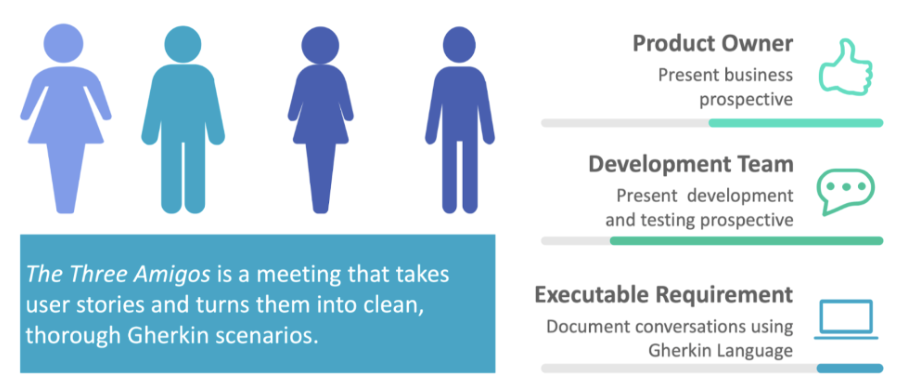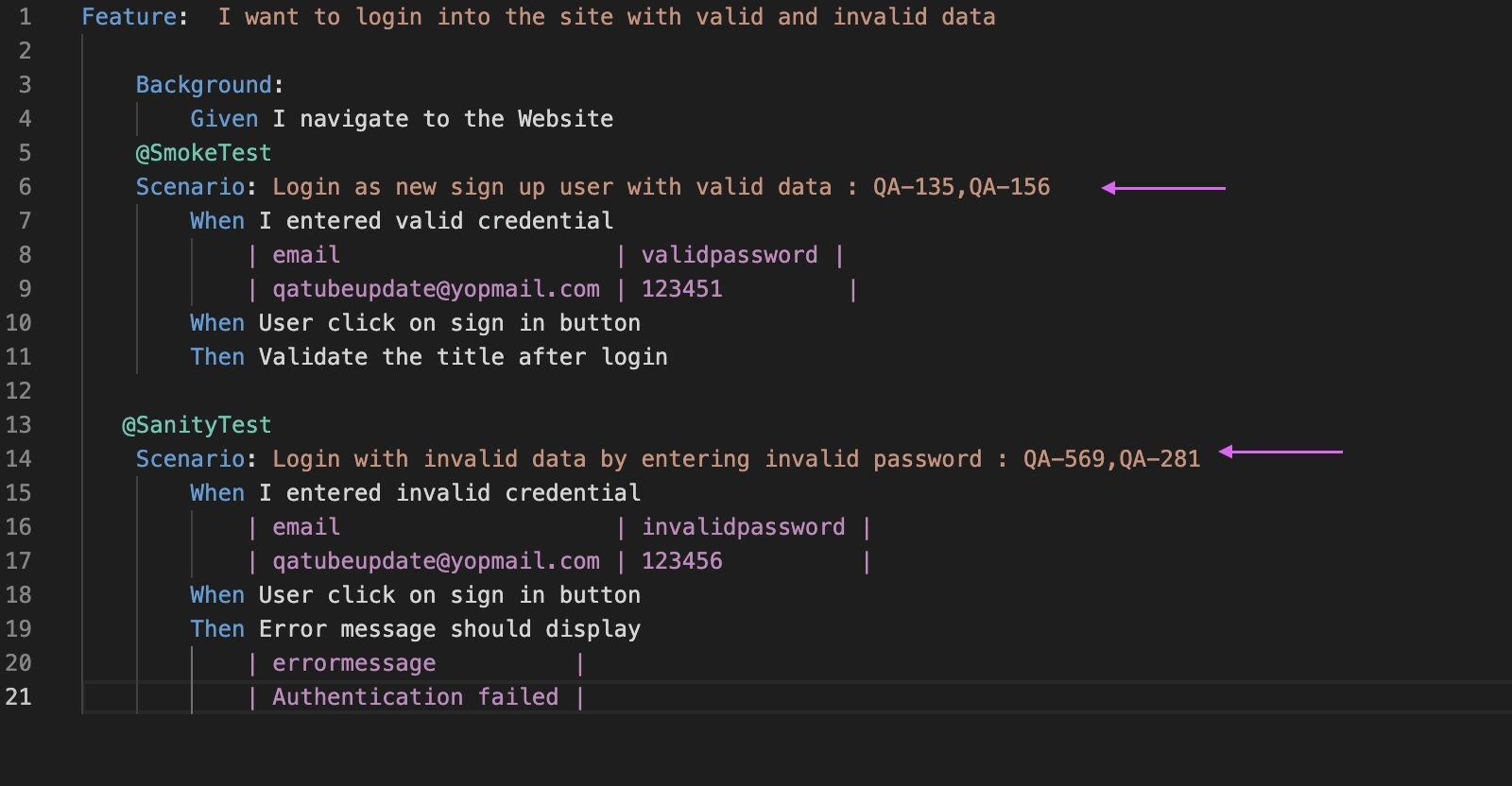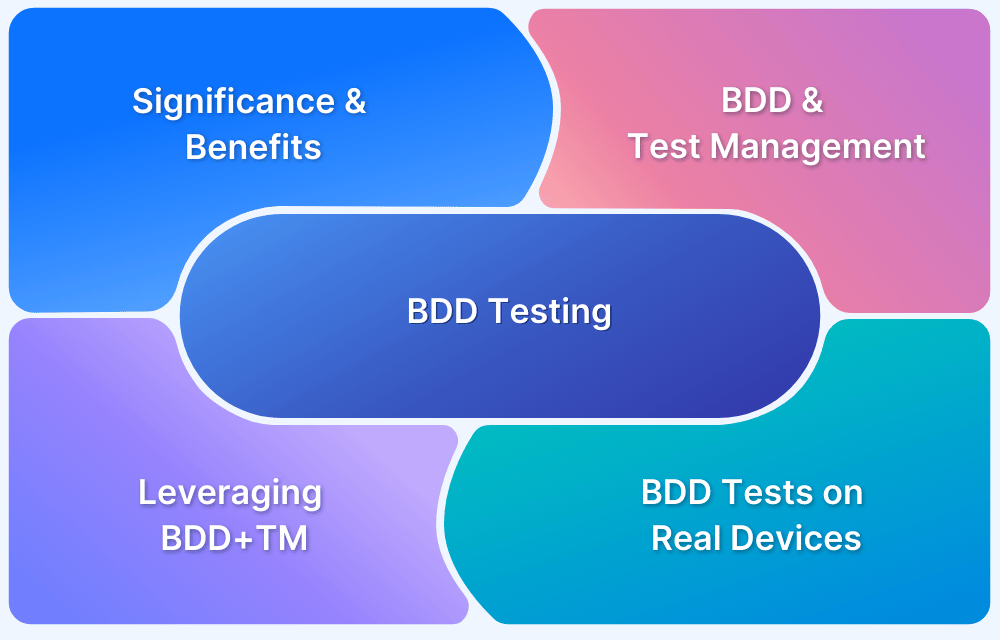Software teams often face unclear requirements, communication gaps, and delayed defect detection, which affect release timelines and product quality. BDD test automation helps overcome these challenges by aligning development with business goals, improving collaboration, and providing fast and reliable feedback throughout the development lifecycle.
Overview
BDD test automation is a practice that combines behavior-driven development principles with automated testing to validate software against clear, business-focused scenarios.
Strategies to achieve advanced BDD Automation:
- Shift left for BDD Automation and write test scripts as early as possible
- Write scenarios optimally for test automation
- Use Platforms that allow framework collaboration
- Make your test cases more modular and reusable
- Boost the power of BDD Test Automation with parallelization
- Leverage Data Tables to store data for automation and use a background in your scenarios
- Mapping BDD Scenarios with ALM Tool Requirements
- Generate automated test reports from BDD Test Automation
This article explores what BDD test automation is, its key components, and practical strategies to implement it effectively.
What is BDD Test Automation?
Behavior-Driven Development (BDD) test automation is a methodology that combines the collaborative approach of BDD with the efficiency of automated testing. It focuses on defining software behavior through clear, human-readable scenarios written in a structured language like Gherkin.
These scenarios describe the expected system behavior from the perspective of end users or business stakeholders.
BDD test automation ensures that these behavior specifications are directly linked to automated tests, which validate the application’s functionality against real-world business requirements. This approach promotes close collaboration between developers, testers, and business teams, reducing ambiguity and improving shared understanding.
By automating BDD scenarios, teams achieve faster feedback cycles, reduce manual testing effort, and maintain a reliable test suite that evolves alongside the product. This alignment of automated tests with business goals ultimately enhances software quality and accelerates delivery.
To streamline this process further, platforms like BrowserStack provide seamless integration with popular BDD frameworks, enabling cross-browser and cross-device testing in the cloud. This ensures that BDD test automation delivers consistent, real-world results at scale.
Key Components of Advanced BDD Test Automation
To build a scalable and reliable BDD automation setup, teams should focus on the following core components:
- Business-Focused Behavior Specifications: Writing well-structured, human-readable scenarios in Gherkin ensures all team members share a precise understanding of the expected software behavior.
- Robust BDD Automation Framework: Select frameworks like Cucumber or Behave that support easy scenario execution and integrate well with existing tools and languages.
- Reusable and Modular Test Design: Creating reusable step definitions and modular test components minimizes duplication, simplifies maintenance, and enables scalable test suites.
- Integration with CI/CD Pipelines: Automating test execution within continuous integration and delivery processes accelerates feedback loops and catches defects early in the development cycle.
- Effective Test Data and Environment Management: Maintaining stable test environments and managing dynamic test data ensures consistent, reliable, and repeatable test outcomes.
Read More: TDD vs BDD vs ATDD : Key Differences
Strategies to Achieve Advanced BDD Automation
There are no silver bullets to achieving advanced BDD Automation, just a few simple steps that need to be followed in a planned and consistent manner.
1. Shift left for BDD Automation and write test scripts as early as possible
Anyone with even the slightest idea of the SDLC can agree that the cost of fixing a bug increases with every step of the process. This is why requirements are KING when it comes to BDD automation. For a process so dependent on testing the “behaviour” of an application, it is imperative to understand the requirements as clearly as possible and to convert them into usable test cases. That is why the Shift Left Testing approach is highly recommended for BDD Automation.
Advanced BDD Test Automation requires closely coupled communication between three major stakeholder categories popularly known as the “Three Amigos”. And it is vital to clear potential misunderstandings at the very beginning.
- Business Team (BA): This team has the Product Owner or a Business Analyst who defines what is the problem to be solved through the product.
- Development Team (DevOps): This team has developers who provide solutions for the problem in question.
- QA Team: These are the testers who find bugs in the product and verify whether it works as expected, and identify any edge cases that can lead to product failure.
The Three Amigos of BDD
2. Write scenarios optimally for test automation
Once the requirements have been clearly understood, it is time to turn them into test scenarios. In BDD, test scenarios are written using the Gherkin language, which uses the “Given-When-And-Then-But” style for writing test cases.
However, since these scenarios are written in plain English, they may sometimes become too convoluted and too lengthy for easy conversion to automated test cases.
Scenario: As an existing user, I want to log in successfully Given the user is on the Home page When the user clicks on the login link on Home Page And the user can see the login screen And the user enters his username and password And the user is able to click on the login button Then the user is logged in successfully And the successful login message is displayed
A far better way is to write these scenarios in a more concise manner with fewer statements overall. This increases clarity and makes the automation steps easier to replicate.
Scenario: As an existing user, I want to log in successfully. Given the user is on the Home page When the user navigates to the Login page And the user enters the username and password Then the successful login message is displayed
3. Use Platforms that allow framework collaboration
Popular automation test frameworks like Selenium and Cypress are preferred for their accuracy and the test execution speed they provide to the overall development cycle. BDD test frameworks like Cucumber adds value to these by allowing for greater collaboration between technical and non-technical stakeholders.
This can be especially beneficial in User Acceptance Testing, which has test scenarios driven by user behaviour.
It is recommended to run Cucumber-Selenium tests on real browsers and devices. Browserstack’s Cloud Selenium Grid of 3500+ real browsers and devices offers unprecedented opportunities to test applications on real devices for greater accuracy.
It is important to tie in conventional BDD frameworks with popularly used automation test frameworks to achieve an ideal combination of speed, accuracy, and behaviour-driven validation.
4. Make your test cases more modular and reusable
Automation tests are often used for repetitive tasks, especially when it comes to regression testing. Thus it is important to make the cases as modular and reusable as possible.
For example, “Given: user navigate to the Shopping Cart” can be one common step that we need in every scenario. So we can reuse this step.
Also, it prevents confusion due to different letter-casing if we try to use it again and again manually.
Given (“Click on ‘Sign In link’ on the Home Page”) Given (“click on ‘Sign In link’ on the Home Page”)
5. Boost the power of BDD Test Automation with parallelization
Tools like BrowserStack Automate allow Cucumber-based Espresso tests to be run in parallel as well as sequentially. By default, the test-suite contents are executed in sequence, but these can be further split into different groups called shards for parallel execution.
This is especially helpful when there are a large number of automated test cases in the test suite.
For example, if the test suite has 500 test cases, and they take a minute to execute, the sequential test execution time will be approximately 500 mins However, splitting this into 10 shards of 50 test cases each can allow them to be run in parallel in just 50 mins.
Note: To use test sharding on Cucumber-based Espresso tests, check out the Cucumber-based Espresso test sharding on BrowserStack
6. Leverage Data Tables to store data for automation and use a background in your scenarios
It is best practice to put the steps that are commonly repeated in every scenario into the background as they are run before every scenario. Also, Gherkin provides for the use of Data Tables to store data for parameterization. This helps in easily creating automated test cases, especially for Regression Testing.
Feature: I want to login into the site with valid and invalid data Background: Given I navigate to the Website Scenario: Login as a new sign-up user with valid data When I entered a valid credential | email | validpassword | | qatubeupdate@yopmail.com | 12345 | When the user clicks on the sign-in button Then Validate the title after login Scenario: Login with invalid data by entering an invalid password When I entered an invalid credential | email | invalidpassword | | qatubeupdate@yopmail.com | 123456 | When the user clicks on the sign-in button Then Error message should display | errormessage | | Authentication failed |
7. Mapping BDD Scenarios with ALM Tool Requirements
For better automated test coverage, it is always important to ensure that all the requirements are mapped to test cases. This is commonly known as Requirements Coverage.
User Stories can be integrated by ID into BDD scenarios for the direct mapping of business requirements to test cases and subsequently into automated test scripts. Cucumber Scripts can map User Story ID from JIRA, as shown below.
Mapping User Stories to BDD Scripts
8. Generate automated test reports from BDD Test Automation
The CI/CD pipeline requires rapid feedback cycles in order to correct bugs and other potential issues and get a deployable product ready for production at the earliest. Leveraging the power of automated test reporting for BDD Test Automation goes a long way in ensuring this.
Tools like BrowserStack App Automate offers automated test reports for Cucumber-based Espresso tests, for example. The specific format of the report can be customized by the user in the plugins parameter and these reports can be downloaded in a PDF version as well.
Why Choose BrowserStack for BDD Test Automation?
BrowserStack offers key features and capabilities that make BDD test automation faster, more reliable, and easier to manage:
- Real Device and Browser Coverage: Run BDD tests across 3500+ real device and browser combinations for accurate, cross-platform validation.
- Seamless Framework Integration: Works smoothly with popular BDD frameworks like Cucumber and Behave.
- CI/CD Compatibility: Easily integrates with CI/CD tools to automate BDD test execution and accelerate feedback.
- Parallel Test Execution: Speed up test cycles by running multiple BDD scenarios in parallel.
- Rich Debugging Support: Get detailed logs, screenshots, and video recordings to quickly diagnose and fix test failures.
- Cloud-Based Infrastructure: Eliminate the need for in-house device labs and maintain test stability at scale.
- Secure and Scalable: Enterprise-grade security and scalability make it ideal for fast-growing or large teams.
Conclusion
BDD Test Automation allows significant returns in terms of your Automation ROI and is fashioned in a manner that is convenient for all stakeholders to understand and stand over. Advanced BDD Automation Tests can be written with natural language constructs to define the behaviour of software for given scenarios while meeting the demand for accelerated product release and optimal quality.
Testing websites on a real device cloud is the only sure-shot way of ensuring complete test result accuracy. It is best to thus opt for real device testing to check cross-browser compatibility while executing a BDD Test Automation suite.








